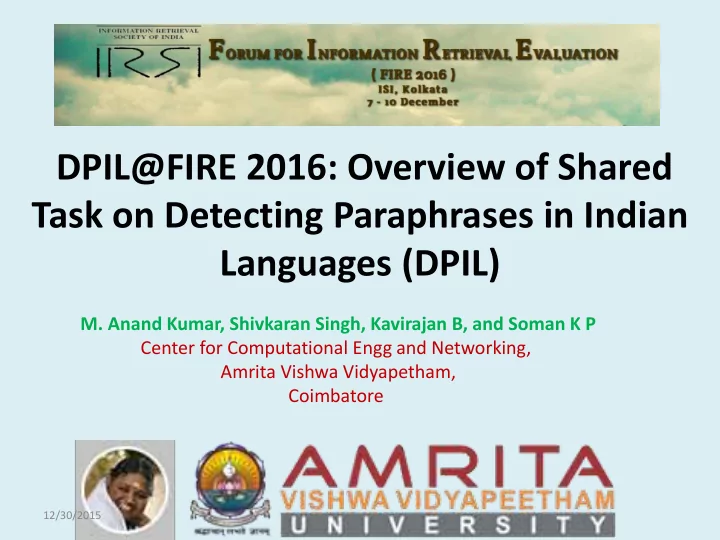

DPIL@FIRE 2016: Overview of Shared Task on Detecting Paraphrases in Indian Languages (DPIL) M. Anand Kumar, Shivkaran Singh, Kavirajan B, and Soman K P Center for Computational Engg and Networking, Amrita Vishwa Vidyapetham, Coimbatore 12/30/2015
Outline • Paraphrase Detection • Motivation • Task Descriptions • DPIL Dataset • Applications • Participants • Methodologies and Features • Results • Conclusion and Future Scope
Paraphrase Detection • Paraphrase detection “find out whether the given two sentences convey the same meaning or not ”. • Four Indian languages (Hindi, Punjabi, Tamil and Malayalam).
• Since there are no annotated corpora or automated semantic interpretation systems available for Indian languages . • Creating benchmark data for paraphrases and utilizing that data in Open shared task competitions will motivate the research community for further research in Indian languages.
Task description • There were two subtasks under shared task on Detecting Paraphrase in Indian Languages (DPIL). – Subtask 1: Given a pair of sentences from newspaper domain, the shared task is to classify them as paraphrases (P) or not paraphrases (NP). – Subtask 2: Given a pair of sentences from newspaper domain, the shared task is to identify whether they are paraphrases (P) or semi- paraphrases (SP) or not paraphrases (NP). Given: A pair of Sentences S1 = { w1,w2,..wm} and S2={w1,w2,..wn} in same language. Task1 : Classify whether s1 and S2 are P or NP Task2 : Classify whether S1 and S2 are P or NP or SP
Applications of Paraphrase Detection • Paraphrase identification is strongly connected with generation and extraction of paraphrases. • Evaluation of Machine Translation system. • Question answering system • Automatic short answers grading is another interesting application which needs semantic similarity for providing grades to the short answers.
Evaluation Metrics
DPIL Dataset Average Number of Words per Sentence
Vocabulary Size vs Tasks • Vocabulary size for Hindi & Punjabi languages is less than Tamil and Malayalam. Tamil and Malayalam are highly agglutinative in nature
Participants • 35 teams registered -11 teams successfully submitted their runs – Working notes 10. Submitted 21 25 Registered 20 15 13 15 11 10 10 7 5 6 5 5 4 0 Registered Hindi Tamil Submitted Malayalam Punjabi ALL
Methodologies • Two teams used the threshold based method to detect the paraphrases, remaining teams used the machine learning based approaches. • Most of the teams used the common similarity based features like cosine, Jaccard, and only two teams used the Machine Translation evaluation metrics, BLEU and METEOR as features. • Very few teams used the synonym replacement and Wordnet features. For Tamil language, team KEC@NLP used the morphological information as features to the machine learning based classifier. KS_JU team used the word2vec embeddings. • The top performing team (HIT-2016) for the three languages used the character n-gram based features and they experimented the results for different n-gram size.
Features used
Sarwan Award Winners
Conclusion and Future Scope • Tamil and Malayalam language accuracy is low as compared to the accuracy obtained by Hindi and Punjabi language. • Discrepancies can be found in manually annotated paraphrase corpus . • Extend the task to analyze the performance of cross-genre and cross-lingual paraphrases for more Indian languages. • Detecting paraphrases in social media content and code- mixed text of Indian languages. • Role of Morpho-Syntactic knowledge with Recursive Auto Encoders in Paraphrase Detection in Indian Languages. • Applying to Machine Translation Evaluation.
References • Dolan, W.B. and Brockett, C., 2005, October. Automatically constructing a corpus of sentential paraphrases. In Proc. of IWP. • Xu, W., Callison-Burch, C. and Dolan, W.B., 2015. SemEval-2015 Task 1: Paraphrase and semantic similarity in Twitter (PIT). Proceedings of SemEval. • Xu, W., Ritter, A., Callison-Burch, C., Dolan, W.B. and Ji, Y., 2014. Extracting lexically divergent paraphrases from Twitter. Transactions of the Association for Computational Linguistics, 2, pp.435-448. • Socher, Richard, Eric H. Huang, Jeffrey Pennin, Christopher D. Manning, and Andrew Y. Ng. "Dynamic pooling and unfolding recursive autoencoders for paraphrase detection." In Advances in Neural Information Processing Systems , pp. 801-809. 2011. • Pronoza, E., Yagunova, E. and Pronoza, A., 2016. Construction of a Russian paraphrase corpus: unsupervised paraphrase extraction. In Information Retrieval (pp. 146-157). Springer International Publishing. • Potthast, M., Stein, B., Barrón-Cedeño, A. and Rosso, P., 2010, August. An evaluation framework for plagiarism detection. In Proceedings of the 23rd international conference on computational linguistics: Posters (pp. 997-1005). Association for Computational Linguistics. • Rus, V., Banjade, R. and Lintean, M.C., 2014. On Paraphrase Identification Corpora. In LREC (pp. 2422-2429).
Recommend
More recommend